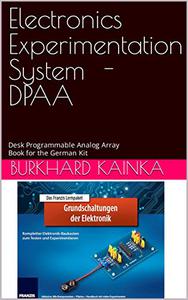
Electronics Experimentation System DPAA: Desk Programmable Analog Array Kit by Juergen Pintaske
English | 2022 | ISBN: N/A | ASIN: B0B52HJ5ZG | 165 pages | EPUB | 7.20 Mb
Foreword
Electronics can be learned like arithmetic, writing and reading: you just need the opportunity to deal with them in detail. The easiest way to do this is by using a small electronics kit. The components in this kit are soldered onto a circuit board and cannot be lost; only the interconnects have to be plugged in - and you have a finished circuit, a functioning system.
The circuit board has three rows of pin headers, each with 2 x 10 contact pins. Small contact bridges are pushed onto these pins where needed, and can be easily removed later. They are also called "jumpers" because they can "jump" back and forth quickly and easily to different positions. After a few examples you will know this system inside out, and can quickly set up new circuits and try out your own ideas as well. This is much quicker than using a soldering iron or a breadboard. And the components cannot be lost. Only a small supply of jumpers must always be within reach.
The components are arranged in such a way, that more than 50 meaningful experiments can be set up using the jumpers alone. And you can probably find a lot more. The most important components are present: light emitting diodes (LEDs), resistors, capacitors and transistors. Anyone who knows these components and has understood them, can also implement own ideas and develop new circuits. The construction is much faster than with other systems. And the most important thing is that you never have to search for the components.
After a few examples, everyone knows the circuit board so well, that they can even implement circuits or develop new ones without a drawing. This opens up completely new possibilities for small experiments anywhere. You can sit in the sun, think of a circuit and just try it out. You should always have a few additional jumpers ready.
For example, they can be placed in a parking position on the lower and upper contacts for the power supply.
Or you can set up competitions with your friends. Instead of the usual cards or dice, the circuit board is on the table. Then a creative task is defined. Who will find the best solution fastest?
Good luck with experimenting!
Burkhard Kainka



